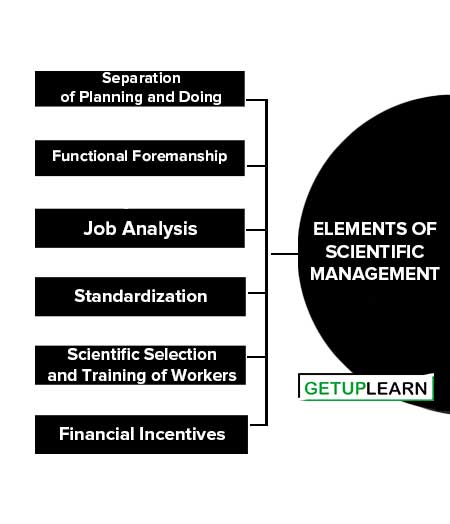The impetus for the scientific management approach came from the first industrial revolution. Because it brought about such an extraordinary mechanization of industry, this revolution necessitated the development of new management principles and practices.
The concept of scientific management was introduced by Frederick Winslow Taylor in the USA at the beginning of the 20th century. He defined scientific management as,” Scientific management is concerned with knowing exactly what you want men to do and then see in that they do it in the best and cheapest way”.
Table of Contents
Elements of Scientific Management
These are the elements of scientific management:
- Separation of Planning and Doing
- Functional Foremanship
- Job Analysis
- Standardization
- Scientific Selection and Training of Workers
- Financial Incentives

Separation of Planning and Doing
Taylor emphasized the separation of planning aspects from the actual doing of the work. The planning should be left to the supervisor and the workers should emphasize on operational work.
Functional Foremanship
Separation of planning from doing resulted in the development of a supervision system that could take planning work adequately besides keeping supervision on workers. Thus, Taylor evolved the concept of functional foremanship based on the specialization of functions.
Job Analysis
It is undertaken to find out the best way of doing things. The best way of doing a job is one which requires the least movement and consequently less time and cost.
Standardization
Standardization should be maintained in respect of instruments and tools, period of work, amount of work, working conditions, cost of production, etc.
Scientific Selection and Training of Workers
Taylor has suggested that the workers should be selected on a scientific basis taking into account their education, work experience, aptitudes, physical strength, etc.
Financial Incentives
Financial incentives can motivate workers to put in their maximum efforts. Thus, monetary (bonus, compensation) incentives and non-monetary (promotion, upgradation) incentives should be provided to employees.
Criticism of Scientific Management
The main grounds for criticism of scientific management are given below:
- Taylor advocated the concept of functional foremanship to bring about specialization in the organization. But this is not feasible in practice as a worker can’t carry out instructions from eight foremen.
- Workers were hired on a first-come, first-hired basis without due concern for workers’ abilities or skills.
- Scientific management is production oriented as it concentrates too much on the technical aspects of work and undermines the human factors in the industry. It resulted in a monotony of jobs, loss of initiative, overspeeding workers, wage reductions, etc.
- The training was haphazard at best, with only minimal use of the basic apprentice system.
- Tasks were accomplished by the general rule of thumb without standard times, methods, or motion.
- Managers worked side-by-side with the workers, often ignoring such basic managerial functions of planning and organizing.
FAQs Section
What are the elements of scientific management?
The elements of scientific management are:
1. Separation of Planning and Doing
2. Functional Foremanship
3. Job Analysis
4. Standardization
5. Scientific Selection and Training of Workers
6. Financial Incentives.














